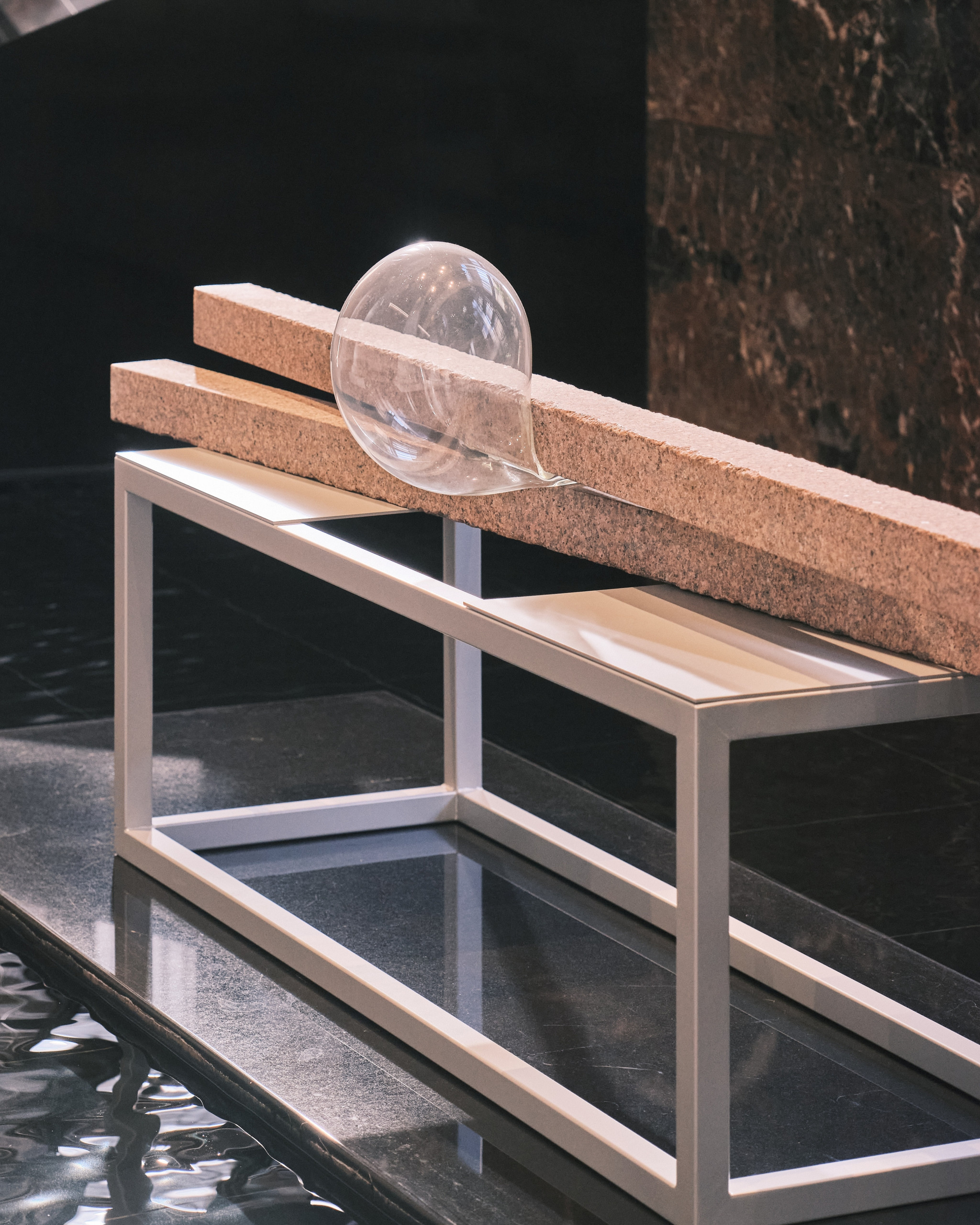They’re the latest in a long, thoughtful practice by Simone Slee, Associate Professor and Head of VCA Art, Faculty of Fine Arts and Music at the University of Melbourne, who has spent three decades letting materials guide the process.
We caught up with Simone to chat about materials, collaboration, and how place and process shape the work.
Q: Your works at 101 Collins explore sculptural, conceptual conditions and material agency. Can you elaborate on how you approach these themes in your practice?
A: I’ve been working with materials since art school—near on 30 years ago! The role of materials has always been central. Not long after art school I was folding large sheets of flimsy tissue paper, pushing the material to stand on end. Of course, with a breath of air they would fall over, but as it turns out that was the point, the tension in the work. I discovered it was about pushing the limits of the material and letting them push back.
Q: In your exhibition, you juxtapose blown glass and stone as versions of the same matter with inverted properties. What inspired you to contrast these materials?
A: People think of glass as fragile and stone as solid. But sometimes, it’s the rock that’s more vulnerable. While glass is made from sand—so it’s technically part of the same material lineage—pairing them flips expectations. I first explored this idea of juxtaposing seemingly inverse materials when I was at art school at the Staedelschule in Frankfurt. At the time I was making sculptures using cardboard with mirror foil. It’s always fascinating to see how materials when juxtaposed together can behave differently and generate new meanings.
Q: You mentioned your materials become accomplices in questioning how things might be held up or held down. Could you explain the role of material agency in your sculptures?
A: Honestly, I was the art student at art school whose sculptures always fell over. I decided to capitalise on what I seemed to be good at – my failures. That unpredictability became part of my language. Later I made a series of sculptures called the Prop Series, thinking of the minimalist sculptor Richard Serra’s Prop works, however with my works I used everyday items such as a cucumber, or a goldfish in a bag (as you would purchase a goldfish from the aquarium), to prop up my cardboard and mirror foiled sculptures until they would fail, or until it was time for the fish to be released back into the aquarium. By the way, no fish were harmed in this artwork! It’s about tension, failure, and the materials deciding on their limits and whether or not they want to behave.
Q: Your sculptures suggest a durational performance, where stability meets the potential for failure. How do you balance the implied permanency of your materials with their dynamic, performative aspects?
A: In earlier works, sculptures would collapse in minutes. With these newer pieces, it’s more of a slow tension. Glass might look solid, but it’s fluid, so eventually, everything will shift. There’s a sense that collapse is always possible–it just takes longer. You can feel that tension even when they’re standing still.
Q: How does your teaching role at VCA Art influence your artistic practice?
A: A lot of what’s so brilliant about teaching is that you learn as much from your students as maybe they learn from you. There’s always a kind of constant dialogue. When you’re working with PhD graduate researchers, they’re diving into whole new fields, and that helps shape the general milieu I’m working in. Working with art researchers and students also gives you a kind of rigour of thinking, around installation, around the logic of the object, around clarifying where the intention of the artwork lies. There’s a particular accountability to the context you’re in. I feel fortunate to be part of this brilliant art school, VCA Art, and more broadly, the VCA and our faculty. It’s a reciprocal relationship.
Q: What’s next for your practice? Are there new materials or ideas you’re keen to explore?
A: I’ve got a show coming up at Heide Museum of Modern Art, working with Senior Curator Melissa Keys. I’ll be working with Heide Modern, the house designed by David McGlashan from McGlashan Everist, a modernist gem crafted from Mount Gambier limestone and a limited palette of glass, timber and leather. The way it’s designed, with walls that don’t touch the ceiling, spaces that float and interlock, really resonates with my sculptural language.
Q: What is the significance of 101 Collins Street to you?
A: I remember when 101 Collins was built. Having a design background in landscape architecture and being aware of postmodernism countering the functional agenda of modernism, it always amused me that the gorgeous monumental marble clad columns don’t really hold anything up. Yet there’s something poetic about columns holding up air. That idea is mirrored in my rock and glass works, where breath which produced the hot blown glass, holds the weight of the stone. And working in a moat was terrific. I hadn't ever thought about installing the works in water which has produced something really very beautiful. I think there's something wonderful about the shimmering effect of the light reflecting in the glass and vice versa. Every new space I work in gives me so much to work with. So, thank you!
At 101 Collins Street, these sculptures don’t just sit still - they hover, lean, and play with our sense of balance. In glass and stone, they ask us to think again about what holds things up, and how we hold space, time and tension.
Simone Slee acknowledges that all rocks in these artworks are sourced from licensed quarries or gifted by landowners. Simone Slee respectfully acknowledges the provenance of these rocks from the unceded lands of First Nations Peoples and pays deepest respects to their enduring work in caring for Country for thousands of generations.
